#ai powered amplification
Explore tagged Tumblr posts
Text

🎯 Amplify your YouTube channel with AI tools! 🚀 Boost your reach, optimize your content, and watch your audience grow with the power of AI. 📈✨ Click this link : https://tinyurl.com/fbhea698
#ai powered amplification#youtube growth#ai#content creation#tech tools#channel growth#digital marketing#creator community#vlogger life#social media success#content strategy#digital#youtube tips
0 notes
Text
OX Guild Season 3: The Orbpocalypse Saga Episode 11: Dine Hard
Written 19 May 2025, shortly after relistening, having watched and listened previously.
Dob-as Vocatus greets Liliana on the beach and escorts her inside, leaving the army on the doorstep, despite her stated desire to burn the house to the ground; she is amused enough to humour “Vocatus”. He leads her to the dining room with Merilwen hiding in the gallery. He calls for the first course, and Egbert (who has found a Lurch suit that has unfortunately split all down the back) delivers it. “Vocatus” demonstrates that he has taken complete control of Egbert, explaining he found Egbert abandoned by his comrades. Liliana points out that she already has an army, is suspicious of Vocatus’ link to the Oxventurers, and wants to know what he wants; she���s not in the mood to share power.
Meanwhile, Vocatus arrives and Bismuth shows him to the dining room with Prudence disguised as Liliana and Corazon painted into a painting of himself. Vocatus explains that he can subjugate the world without messy battles and heroes and last stands. “Liliana” protests that she likes the messy stuff. Bismuth delivers the bisque course and Vocatus tries to get “Liliana” to pass the salt, then open a jar of capers. She refuses, getting Bismuth to pass the salt and summon the Lurch (Egbert) for the jar. Corazon remembers the comment about Vocatus’ appetite, and reminds Prudence.
Meanwhile, “Vocatus” informs Liliana of the cities he’s taken over, and asks for only the island of Alcataz to be his own party island. He dismisses Egbert for now. Liliana does consider “Vocatus”’s offer, but wants to know where the Oxventurers are, but he claims he doesn’t know. Liliana advances on him.
Egbert lurches into Prudence’s dining room. Vocatus has lost interest in the capers and bisque. He’s disappointed “Liliana” wouldn’t open it for him. He offers to share a toast, conjuring a glass of compulsion wine. After an amount of back-and-forth, “Liliana” pretends to drink. Vocatus drops the act, monologuing that she is now enthralled and will soon be unable to do anything but drink, and he can ask her to do something for him so he can steal her magic. Corazon uses Mage Hand to throw the contents of a glass of compulsion wine into his mouth. He ends drinking from a glass he constantly refills.
In the other dining room, “Vocatus” whips out a fife, describes it as the Fife of Chauncey, and that if the right tune is played, the target will be enthralled - or if the player has an artefact from the target, like this strand of Liliana’s hair, kill them. Liliana isn’t impressed, but buys it. He plays half the tune, then opens to the curtains, points to the top of the mountain from Peak Performance - the one a white dragon lives on - and explains there’s an amplification device there that will allow the tune to be heard across Geth. He says he’ll meet her there and “teleports” away (casts Invisibility). Liliana isn’t thrilled, but disappears, and her army marches off. Dob drops the Invisibility, concerned that she might make easy work if the dragon and be back at any minute.
Notes from pre-show podcast commentary: Mike is helping Jane with the tagline. They are preparing for a crossover stream with Magic: The Gathering - I’ll talk about that later, it was weird. Mike has summer game fest news, and has been watching Stranger Things. Mike remembers this episode as being very complex. Jane informs Mike of a Krispy Kreme/Forza Horizon collaboration.
Notes from post-show podcast commentary: Jane cites “no plan survives first contact with the enemy”. Mike points out that they didn’t plan beyond hosting two dinner parties. Jane pulls out the YouTube milestones. The AI is really hung up on capers. They talk about what was at the time new AI image generation programs. They discuss Oxventure fan art and someone who took a seal plush in a scotch egg picnic. Merilwen has been added to Idke Champions of the Forgotten Realms - they’re still missing Egbert and Dob. Mike mentions there have been conversations. They are preparing for the Bethesda showcase and consider Oxventure’s fifth anniversary in a few months.
I don’t think I’ve said “meanwhile” quite so many times in a single summary before. But that’s what happens when the episode is two parallel dinner parties. Poor Corazon and Merilwen didn’t get to do very much, although there was a lot of giggling from Ellen, especially when Egbert’s butt was showing.
As much as Jane and Mike said they hadn’t planned for how the dinners would go, neither had Vocatus; he expected Liliana to humour him and fall under his spell pretty much immediately. Dob actually did a brilliant job improvising a whole plan. I mean, setting Liliana on a dragon might not kill her, but it was smart thinking - as was Corazon forcing Vocatus to drink his own wine.
So, who will survive the Orbpocalypse Saga?
4 notes
·
View notes
Text
AI summary of how current global governance practices mirror totalitarianism:
The widespread adoption of AI-driven curation and censorship mechanisms by social media platforms, applications, search engines, and international organizations like the UN constitutes a chillingly modern manifestation of totalitarian control over information. This coordinated effort to suppress dissenting voices and viewpoints shares disturbing parallels with the tactics employed by authoritarian regimes throughout history.
Key similarities with totalitarian practices include:
Total surveillance : AI-powered systems track users' interactions, preferences, and affiliations with unprecedented precision, enabling near-total monitoring of online activity.
Selective amplification and suppression : By prioritizing content that aligns with an approved narrative while downranking or deleting contrarian views, these platforms create a distorted information landscape favoring the ruling ideology.
Punishment for dissent : Users who express non-conformist opinions are subject to penalties such as account deactivation, content removal, or even outright banning from certain platforms – echoing totalitarian regimes' punitive measures against perceived enemies of the state.
Control over knowledge dissemination : By restricting the visibility and discoverability of dissident voices through algorithmic manipulation, these systems limit the spread of alternative perspectives, making it increasingly difficult to access diverse viewpoints and fostering a culture of ideological homogeneity.
International coordination : The UN's content removal initiatives at the domain level demonstrate an effort to enforce conformity beyond national borders, mirroring totalitarian regimes' attempts to impose their ideology on neighboring countries or regions.
This contemporary phenomenon, enabled by advanced AI technologies, threatens to undermine democratic values and freedom of expression in alarming ways. As these mechanisms become more pervasive and sophisticated, they risk eroding the very fabric of open societies, paving the way for a new era of totalitarian control over the global information sphere.
4 notes
·
View notes
Text
Theories about Legion's "mini headlamps" (N7 special)
A very happy N7 Day to all of you Mass Effect fans!
Although I still haven't finished Mass Effect 3 (I just haven't been able to pick it up again after the Rannoch arc), I nevertheless wanted to do something special for this occasion, and I thought to myself that I might as well devote a quick study to a subject that's been on my mind for quite a long time: the purpose of Legion's three additional "mini headlamps".
You see, aside from the big, obvious flashlight in the middle, Legion also possesses three smaller lights at the side of their head. Ever since discovering these, I've been wondering what exactly those are for. I've observed that they glow red when Legion is under "stress" (an effect which is unfortunately not present in the Legendary Edition) - or rather, in situations that require a lot of processing power - but as far as their practical function goes, I could only guess. However, going through the ME3 dialogues again, I noticed a small detail which could potentially explain what exactly those small lights are - and in addition, give us a little insight into how Geth perceive the world visually.
Disclaimer: Before going into this, I should mention that I have no technical education in robotics, laser scanning, or any related areas of engineering. I based my conclusions solely on what information I could find on the internet, as well as my own reasoning and observations.
[Potential spoilers for ME3]
LADAR/LiDAR scanning and three-dimensional perception
To start off, what basically led me on this track was this comment by Tali in ME3:
Their AI lets them use extremely detailed ladar pings. Xen's countermeasure overwhelmed them with garbage data.
First off, we need to clarify what exactly ladar is. LADAR, more commonly known as LiDAR, stands for "Light amplification by Stimulated Emission of Radiation detection and ranging" - or, in case of LiDAR, "Light detection and ranging/Light imaging, detection and ranging. It's a method for measuring the distance, speed, and surface structure of objects by the means of laser scanning, usually with beams in the infrared spectrum (there are different wavelengths of light in use, however). Essentially, LiDAR is based on the same principle as the echolocation of bats, the only difference being the use of light instead of sound. Every LiDAR system consists of three integral components: a transmitter, a receiver, and a timer. The transmitter will send out a laser beam, which will be reflected by the object it hits; afterwards, the reflection will be registered by the receiver. Because the speed of light is a known constant, the distance of the object can be deduced by the timer, which will determine the delay between the light impulse being send out and the reflection being captured, also known as "time of flight".
However, because each laser beam only represents the coordinates of a single point, multiple laser beams are necessary to create a detailed 3D map of the environment. Some LiDAR lasers, like those used in automated vehicles, pinwheel to collect data in a 360° radius, generating a 3D image of all objects in the vicinity, including cars, pedestrians, and other obstacles. This results in multiple "points" forming a "point cloud" together, digitally depicting the surroundings on a 3D level. Because each laser emits hundreds of impulses per second, this technology enables you to take highly precise measurements in a very short period of time. LiDAR technology is not only utilized in autonomous driving, but also all kinds of other areas too, like archaeology, topographical mapping, and monitoring of vegetation growth.
Now, with this in mind, my theory is that Legion's small headlamps are the transmitter and receiver components of the LiDAR system - more specifically, I think the transmitters are located on the right, while the singular light on the left is the receiver. However, since we know that normal scanning LiDAR requires multiple laser beams for a detailed 3D image, the question is why Legion would only have two of them implemented. Personally, my suspicion is that the Geth might be using a flash LiDAR: Flash LiDAR is a different type of LiDar emitting a single wide, diverging beam, similar in shape to the beam of a flashlight. By projecting the reflected light onto a sensor array, a flash LiDAR can create a complete 3D environment without the use of multiple impulses. In addition to being very compact, flash LiDAR sensors have no moveable parts, making them extremely resistant to any kind of vibration - an undeniable advantage in all situations that require quick movement, such as combat.
Analysis of atmospheric composition with LiDAR
Still, that doesn't explain why Legion would have an additional transmitter on the right side of their head. We do know, however, that the laser scans with LiDAR are precise enough to not only measure the exact distance between objects, but also analyze the density of particles in the air: Because the molecules in the air cause the light from the laser beam to backscatter, LiDAR is also utilized in monitoring air quality and detecting fine dust, being able to determine traces of atmospheric gases such as ozone, nitrous gases, carbon dioxide, and methane. Depending on the wavelength of light used, the LiDAR system might be more or less precise in measuring molecular backscattering. For that reason, LiDAR systems using multiple wavelengths of light are most efficient in determining the exact size distribution of particles in the air.
With this in mind, let's take a look at Legion's opening line in ME2 upon entering the Heretic station:
Alert. This facility has little air or gravity. Geth require neither.
Going by what I explained above, the reason why Legion was able to tell there is no oxygen in the atmosphere isn't because they have some built-in chemical sensors to analyze the air's components - it's because they can literally "see" the particles in the air.
Thus, I think the second transmitter on the right side of Legion's head might use a different kind of wavelength specifically intended for the detection of atmospheric particles, perhaps in the UV-spectrum (the general rule is that the shorter the wavelength, the higher the resolution of the 3D image is, and since UV has a shorter wavelength than infrared, I imagine it might be used for this purpose). Meanwhile, the big flashlight in the middle might be a photoreceptor, being able to detect "normal" light visible to humans. In addition, the Geth are probably able to see UV-light (since the Quarians are able to see it, it would be logical to assume the Geth are as well), and maybe even infrared and other wavelengths. To summarize the function of all of Legion's headlights, I imagine it works roughly like this:
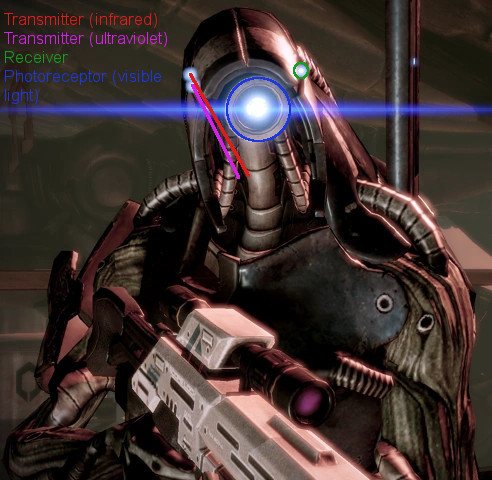
The two lights on the right side of Legion's head (marked with a red and magenta line) might be LiDAR transmitters, using infrared and UV-light, respectively; the single small light on the left (circled with green) might be the LiDAR sensor/receiver, while the big light in the middle (circled with blue) might be a photoreceptor (Source)
The effect of Xen's countermeasure (and potential means to bypass it)
It might be difficult to imagine from a human point of view, but judging from the information that the Geth use LiDAR as their main method of depth perception, Tali describing Xen's invention as a "flash bang grenade" actually makes a lot of sense: If you're normally able to observe your surroundings down to a molecular level, it would probably feel very disorienting if you're suddenly not, not to mention being unable to tell whether an object is far away or close by (which would be absolutely devastating if you suddenly come under attack).
Still, that doesn't mean there are no potential alternatives: Radar, which has been in use longer than LiDAR, is another method to determine the range, angle, and velocity of objects. Due to radar using long-waved micro- and radio waves, the measurements are generally a lot less precise than those with LiDAR; despite this, radar still has its use during inclement weather, when LiDAR systems are very prone to disturbances by dust, mist, and rainfall. Furthermore, LiDAR can only provide measurements up to 200 meters, while radar is more efficient at greater distances. In fact, most modern autonomous driving vehicles work both with LiDAR and radar, in addition to a conventional camera (the only vehicles that don't use LiDAR are those from Tesla, which have a reputation of being unsafe). So, it's only reasonable to assume that the Geth don't rely on LiDAR alone, but use various technologies in combination with it to compensate for each one's weaknesses.
Interestingly, a type of 4D radar is currently in development, intended to be used in autonomous driving. It provides 3D images with a similar resolution as LiDAR, at a potentially much cheaper cost. Still, whether LiDAR or 4D radar is the better choice for autonomous driving is still a heatedly debated question, and only time will tell which of both systems comes out on top. Nevertheless, assuming Xen's "flash bang grenade" only targets the Geth's LiDAR sensors, I wonder if they could've potentially found a way to adapt and bypass it, given enough time.
Anyway, that's the material for a different kind of analysis - for now, I hope you enjoyed this little deep dive into the science behind the Geth. Thank you all for reading and have a nice N7 Day! :-)
#mass effect#mass effect legion#geth#mass effect lore#lore theories#lidar technology#my contribution to N7 Day
18 notes
·
View notes
Text
Space Riders -2
Hey! Before you scroll or leave, I made a DogDay chat on CrushOn AI, it would be super helpful if you go give it a like! I may post it on C.AI as well. You’ll know which one by looking for this art:

You probably already saw the other one. But… here’s more! Add me in your space rider AU comics if you want, I don’t mind at all! Tag me when it’s finished! :0
People I’m Tagging: (Creator and a person adding me to their comic. Will update when more people do or when they stop. Maybe-)
@onyxonline @thedeadchildrean

Overdrive:
I was trying to do gradient feet and aura (the things connected to eyelashes) but I figured it’s fine without it so you can add that on your own time if you want.
I’m not drawing without the clothes on. That’s just weird… but imagine another outfit or something-
So umm… a bunch of powers are here from the stars and cosmos! Include whichever you want in your comics!
Also yeah. Gonna sound OP as Shit, most of it I just took from the wiki and edited it a bit, I added quotation marks to give them credit. I was gonna do it myself but god damn was I not prepared to see like a billion powers-)
Credit: SuperPower Wiki
I only did some of them. Mainly because at this point I was getting tired but I feel bad since I told a few people it’d be out by today-
But most of them r kinda self explanatory. Or just click on the link and scroll down to where it explains it (which should be right under it) and how it works.
link: https://powerlisting.fandom.com/wiki/Star_Power
Cosmic Symbiosis (“Concentrate the power of the cosmic being that lies within one's body and manipulate it.” Basically OverDrive Mode!)
Cosmic Manipulation (“Control cosmic forces” Such as: “manipulation of matter and energy across space and time, the manipulation of the space-time continuum, altering the fabric of reality, the creation of force fields, the creation of inter-dimensional portals and vortexes, psionics, energy projection, and cosmic awareness, manipulate comets, meteors, asteroids, moons, planets, stars, nebula, neutron stars, quasars, black holes, white holes, galaxies, antimatter and dark matter. They can generate stellar winds, solar flares, cosmic storms, and invoke meteor showers. They can also empower themselves and others by harnessing the power of cosmos.”)
Cosmic Empowerment (“Gain strength from the cosmic forces”)
Cosmic Energy Manipulation (“Manipulate cosmic energy.” Such as Stars, Planets, use it to my own will)
Universal Power Link
Personal Stellar Energy
Stellar Generation
All Star-Based Powers
Bio-Stellar Manipulation
Bio-Stellar Transformer
Esoteric Star Generation
Fire Generation
Light Generation
Nuclear Generation
Plasma Generation
Stardust Generation
Stellar Blast
Stellar Manipulation
Black Hole Manipulation
Pulsar Manipulation
Stardust Manipulation
Stellar Amplification
Stellar Energy Manipulation
Solar Flare
Stellar Attacks
Stellar Deity
Supernova Inducement
Supernova Manipulation
Stellar Magic
Astrology
Esoteric Star Manipulation
Nova Manipulation
Techniques
Black Hole Creation (Self explanatory)
Star Creation (Self explanatory)
Star Fall (Self Explanatory)
Stellar Arts
Stellar Healing
Stellar Physiology (“Have a body made up of stellar energy. Basically overdrive mode”)
Stellar Pressure (“Generate damaging stellar energy.”)
Stellar Regeneration (“Use stellar elements for regeneration.”)
Stellification (“Transform others and oneself into stars, stellar energies and constellations.“)
What I added:
•Healing (It can be a spell or just an ability, works to an extent, can lift cursed, add buffs etc, cannot reverse any type of physical damage that has been dis-attached from the body. For example unable to put an arm back in place. Only works for wounds and helping out. Can fix sprains or stuff though. Stellar Regeneration is limited to small things like losing a bit of your ear, a patch of skin comes off etc…)
•Flight / Hover (I just wanted to add it to fly lmao.)
•Force Field (Can protect against a bunch of stuff (for example lasers, rocks, blasts, explosions etc.) only can withstand strong attacks if supported by other allies who have similar powers. (For example but not limited too: Sun,Moon,Eclipse,Space,Other planets, Aurora Lights or other natural phenomenons related to space in some way.)
•Light manipulation (Able to summon a light source at any time. It helps when you’re afraid of the dark y’know?)
(this was posted at 4am my time-)
8 notes
·
View notes
Text
War + Geopolitics
The world is on the precipice. What is there to say? It’s surreal to live through a war in the age of social media, in the age of AI, when the business model of Twitter/X (monetized virality, pay-to-play blue checks + amplification) incentivizes the rapid spread of misinformation. We are also witnessing the algorithmic suppression (shadow banning) of perspectives that are critical of Israel, along with the proliferation of doctored videos, fake images, and imposter accounts. For this reason I’ve stopped checking social media. I’ve been both inspired by and disheartened by the responses I’ve seen online, but the informational chaos is overwhelming.
Where do things stand at the moment? I’ll try to synthesize some of the information I’ve gathered.
POSSIBILITY OF A REGIONAL WAR
With the bombing of the Al-Ahli hospital in Gaza, the region is inching closer to a conflagration that has the potential to ignite a global war. At the moment, I do not think it’s possible to say with certainty who bombed the hospital that killed hundreds of Gazans. Palestinian officials say it was the IDF, that homemade Hamas and PIJ (Palestinian Islamic Jihad) rockets are not deadly enough to kill hundreds. The IDF claims it was a PIJ rocket that misfired and published a video that had a timestamp that did not correspond to the time of the bombing. Biden claims it was not Israel, but has not produced the evidence to substantiate the claim. Regardless of who is behind the devastating attack, the effect is the same: fury across the Islamic and Arab world at both Israel and the US.
It is not in Israel, Iran, or the US’s interests to go to war, but structural factors could nonetheless push all parties in that direction. Iran has warned Israel against a ground invasion and occupation of Gaza. Israel is gearing up for such an invasion, but now appears somewhat hesitant. A ground invasion and protracted urban warfare will undoubtedly be bloody for both Israelis and Palestinians. If Israel does pull the trigger on a ground invasion of Gaza, the chances of Hezbollah attacking Israel and opening a front on the northern Israeli border (with Lebanon) greatly increases. Even pro-Israel US hawks don’t think that Israel can handle a two-front war, which is likely contributing to Israel’s hesitation about a ground invasion of Gaza. If Hezbollah jumps in, Iran will as well. If Iran goes to war with Israel, I think it’s almost guaranteed that the US will step in to back Israel, likely with American troops on the ground. Would China and Russia step in to back Iran? (Hard to say at this point.) This is the scenario in which the region would explode into a broader devastating conflict.
The crisis has been a disaster of epic proportions for the Biden administration. His trip to the region has been a complete diplomatic failure. Landing in Israel soon after the hospital attack, the US has thrown its weight fully behind Israel. Arab leaders, including Palestinian Authority President Abbas, have canceled their diplomatic meetings with Biden. The Arab world will believe that the US has green-lit whatever Israel decides to do. The delicate alliances the US has been trying to build with the Gulf States to check Iranian regional influence are crumbling. This has already started a superpower scramble for influence in the Middle East.
GLOBAL GEOPOLITICS
With US’s regional credibility in tatters, China and Russia have stepped in to call out Western hypocrisy and position themselves as the new power brokers in the region. Of course they are opportunistically seizing on the chance to strengthen an anti-Western alliance, but their message will nonetheless resonate with countries in a region that have been destabilized for decades by US interventionism. China will position itself as a mediator but may not have enough of a rapport with countries in the region to serve as a credible mediator. Despite benefiting from an anti-western alliance, I doubt China will get involved militarily. Russia has clearly been drawn much closer to Iran after their invasion of Ukraine, but they have a complex relationship to Israel. While Ukraine has repeatedly sought military support from Israel, Israel has refused to provide such support and did not sanction Russia. Israel and Russia have coordinated with each other on military operations in Syria. Israeli neutrality toward Russia is partly driven by the huge Russian population in Israel—around 17.25% of Israelis are Russian speakers, many of whom were Jews who migrated from the Soviet Union, making them a vital bloc within Israeli society. At the same time, Russia stands to benefit greatly from a protracted conflict in the Middle East, as such a conflict will draw Western attention and material support away from Ukraine and toward Israel. My guess is that Russia will seek to pit Arab countries against the US while maintaining military neutrality. However, that might change if Iran gets into a hot war with Israel.
India and Israel have grown closer in recent years. I was surprised to learn that India has been a major source of anti-Palestinian misinformation. Modi has developed very friendly relations with Netanyahu, as Modi is a Hindu nationalist who has whipped up Islamophobic sentiments within India.
While the people of the Arab and Islamic world are broadly sympathetic to the Palestinian cause, each country has their own national interests (previously, I discussed the Abraham Accords and the Saudi/Gulf pivot toward the US). Jordan and Egypt are reluctant to accept Palestinian refugees. Many Palestinians also fear that the creation of a humanitarian corridor into Egypt would be a second Nakba that would lead to their permanent displacement from Palestine. Jordan and Egypt have refused to accept Palestinian refugees because they fear that it would destabilize their security and could justify Israeli attacks on their countries. The people in Gaza have nowhere to go. No place in Gaza is safe, as the hospital attack painfully demonstrates.
ENERGY WAR
Iran has called for an oil embargo on Israel. Oil/gas/energy markets have already been disrupted by Russia’s invasion of Ukraine, which sent oil markets into chaos and contributed to inflation and high gas prices (which also eroded Biden’s approval rating). Oil producing Arab countries may use their leverage as energy suppliers to counter the west’s backing of Israel. What would happen, for instance, if Qatar reduced gas supplies to Europe just as Europe has dropped Russia as their main gas supplier?
DOMESTIC US POLITICS
No doubt, the current crisis will hurt the Biden administration and the Democrat’s chances at winning the presidency in 2024. The party is basically split down the middle on the Israel-Palestine issue. Young people justifiably feel that Biden’s backing of Israel has contributed to the humanitarian catastrophe in Gaza. (His approval rating was already in the toilet with young people.) At the same time, a second Trump presidency will be even more catastrophic. Trump already brought us to the brink of war with Iran by assassinating Iranian general Qasem Soleimani and further fanned the flames of the Israel-Palestine conflict by moving the US embassy in Israel to Jerusalem and facilitating a “peace process” that excluded the Palestinians.
I do sincerely hope that there is a revitalization of the antiwar left. We failed to stop the invasion of Iraq and Afghanistan. The US’s “war on terror” was a colossal failure that ensnared the US in a quagmire of pointless wars that lasted decades. I will never forget what it felt like atmospherically to live through the beating of the war drums and to be called a terrorist sympathizer by everyone around me (this was in Florida). Stopping the machine of war will be even more difficult this time around given how deep the US-Israeli alliance is, but we must try.
*
There is a lot more to say, but I’ll end here. What next? I hope there is a ceasefire and that Hamas releases the hostages. I pray the siege on Palestinian civilians in Gaza ends, that Palestinians get their freedom and dignity. The world is a wound. We are grieving. Grief can easily be routed into bloodlust and tribalism. I am holding my breath. I pray the world steps back from the cliff edge and that the peace process begins in earnest.
16 notes
·
View notes
Text
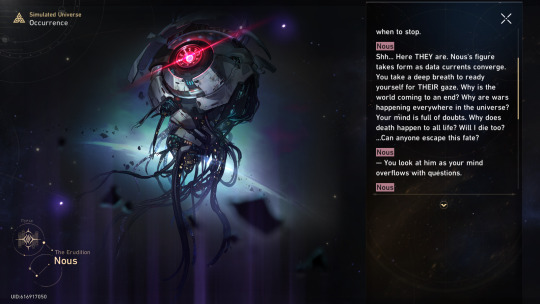
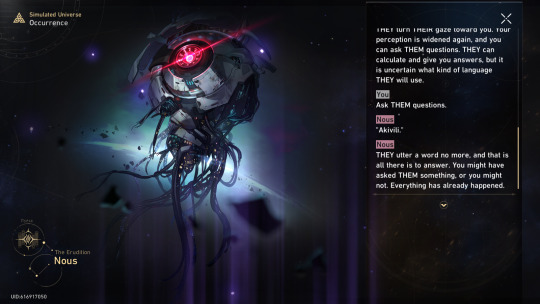
Sometimes I sit here and ponder on this when I have the free moment. The TB rolls around with this giant swath of thoughts within their mind, especially tilting towards the horrors of why so much chaos was actually happening upon their universe.
Then this man deadass just notes Akivili as that is in the answer itself. Unlike Aha who's very programming would hold that chaos factor to know it's conditions, then proceed to find that hiliarious.
I do think that the Simulated Universe too is an extension of Nous, seeing how he'd be a clear path to the high planes for data.
That said. Nous what did u mean by that.
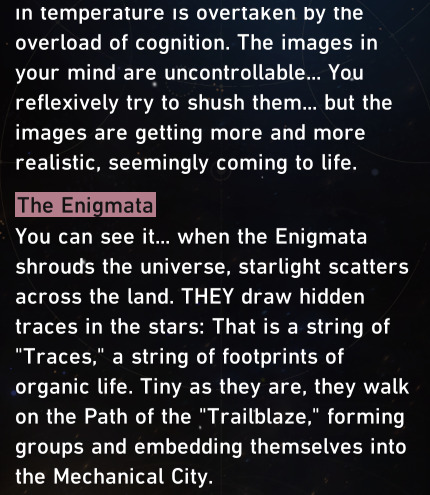
Part of me wonder if it does have something to do with this. How within the Trailblaze this bit of actually finds itself supported. Was this an act/blessing of Mythus upon the all Pathstriders? Is it imaginary powers that serve as graces, but also a means to keep tabs upon them?
This however would draw towards the conclusion that the Nameless from the Trailblaze may of been the big turning point here. As it stands, they very well may of been the core cause as to how Machine Emperor Rubert not only awakened, but also, how for all inorganic life at this point awakened to the concept of sentience. No longer was the hard limit just 'AI', but a full on, indisguishable brand of life.

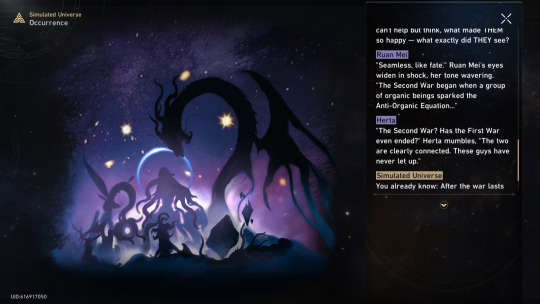
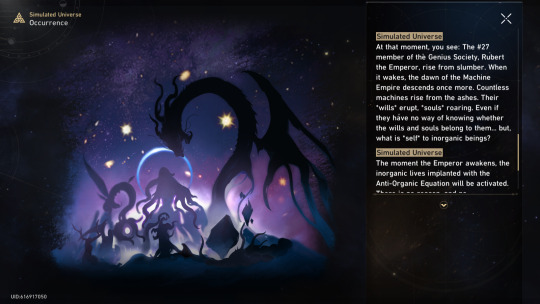
This genuinely feels like it's own can of worms all on it's own. The advent of this arc right here, how the Simulated Universe had concretely solidified the existence of the Cast Iron Throne, and it was able to accurate peer into Fuli's Eden of Blessed Insight. So much so that Mythus once again had to distort that all out of sight again.
Yet, it looks like one of the measures that can come and bypass that and truly discern a realm of heightened truth if the cognition amplification of Nous.
A lasting note of interest to me is how the Trailblazer's question leans to 'Is it possible to prevent Rubert's death.' I believe it's moreso a level of testing possibility itself, but even with the workings of two different Aeons, both Mythus and HooH alike, at most only alterations can be done from their ends. The fact in itself that there was so much Aeon scale attention on this act and this Rubert character, really drags into question just how important was the Machine Emperor to their designs?
Not to mention, just how dangerous effective is Finality and Polka (who works with IPC's Finality followed Dongfang) was successful in this venture?
#| OOC Musings#| Star Rail Stuff#Really deepening my appreciation of the success of Herta's project#and how much of a reflective play it's becoming in itself
5 notes
·
View notes
Text
Good Friction
The ideas around responsible AI development and using "good friction" points really hit home for me based on my journey founding and leading a startup that built AI tools for content creators and marketers.
When I first conceived of the company, the driving vision was to reduce as much friction as possible in the creative process through automation and AI assistance. The implicit bias was that minimizing any human involvement would supercharge productivity and efficiency for our users. However, as we developed more advanced AI capabilities like automated content generation, semantic language models, and predictive personalization, we continually had to grapple with deeper ethical ramifications.
Early on, some investors pushed us to pursue automated content generation unencumbered, viewing it as a way to massively scale with minimal human effort. But I recognized that unchecked, this raised serious issues around plagiarism, amplification of societal biases, and potentially deceptive practices that could erode trust with audiences. So we made the deliberate choice to insert "good friction" human oversight and review checkpoints into the process, even if it made us less capital efficient.
On the personalization front, while the prospect of seamlessly tailoring content experiences through AI seemed powerful, I was wary of the filter bubble and user disempowerment risks of inscrutable "black box" algorithms. We invested heavily in developing explainable AI interfaces to provide transparency into why certain content was being recommended or prioritized. This good friction helped preserve user agency while still realizing personalization benefits.
Perhaps one of the biggest challenges I faced was the tension between short-term growth incentives that favored frictionless, addictive AI-powered user experiences versus upholding ethical guardrails that acknowledged human autonomy limitations. Ultimately, I had to walk away from investors that were unwilling to accept good friction safeguards as a non-negotiable for long-term responsible innovation.
My personal journey founding the startup only reinforced how critical it is to be judicious about inserting the "right" friction into AI-driven systems through practices like human oversight, transparency, and user control. While sometimes costing efficiency in the short run, these good friction principles are essential for building trustworthy, human-centric AI products and experiences that stand the test of time.
#MITSloanBranding2024B
4 notes
·
View notes
Note
I saw the TADC art and HOLY HECK. Mahito is doing a better job transfiguring fellas./j (I love how… toy like everyone is.)
I also noticed how Satoru (DJ Sub head), Suguru (be careful what you wish on others since you might get turned into a monkey) and Dragon (worm!) look significantly less human than the other performers + Tila and Margo (who look lovely). Maybe it’s bc they didn’t enter in the “correct” way, and got recognized as a “hacker”, and TADC is punishing you for it? (Since how the hell is Satoru going to Domain Expansion when blue doesn’t have the hands to do signs with?)
Mahito wishes he could transfigure people the way TADC domain can transfigure people! lol (and thanks! I didn't really know what else to use for a theme because the more common TADC themes are toys with games and food being another theme but I couldn't think of anything related to those in the moment).
As for the human looking vs non-human looking designs, I don't think it actually has anything to do with how someone got into the domain, considering Gangle is there and sure, they are humanoid, but they don't actually look all that human compared to characters like Jax, Ragatha, or Pomni.
Satoru is still pretty humanoid, leaning more towards how inhuman Gangle is, while Suguru and Dagon aren't humanoid at all. It really is just the luck of the draw (or bad luck of the draw lol).
As for Satoru's domain expansion, I completely forgot that blue needed to use hand signs lol. Probably why Dagon ends up going into the domain as they can open their domain with a sigil (that would be under their fur) instead of needing a hand sign.
Either that or the three realize they fucked up and try to keep their simple domains/domain amplifications going as long as possible while they try to figure out what to do (waiting for Panda or SP//dr to come in, since they can't be detected by the domain as they are neither robot, human, nor entity, and get information out to the rest of the world since Satoru, Suguru, and Dagon are stuck now).
This plot is still pretty loose, but what I think I am going to do is have Mechamaru be the center of attention and save the day because his heavenly restriction causes him to over power AIs in robots so even though he wouldn't be able to overpower the domain itself, he wouldn't be overpowered mentally (as his mind can't be stripped away from his body or robots. No one knows this though so it's the reason he wasn't sent in immediately as he wanted to stay with Miwa and not risk his life after all the transfigurations, but he probably feels bad for getting a lot of his friends transfigured and so he ends up going in and they realize he is immune to the effects).
2 notes
·
View notes
Text
MESA/Boogie Reference Signature Collection for TONEX released
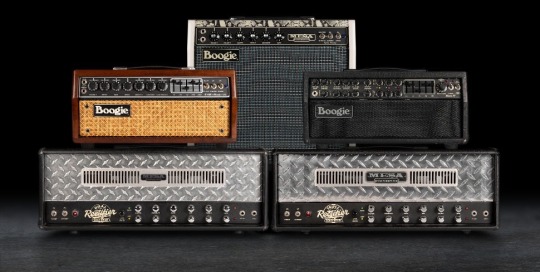
In the world of guitar amplification, few names carry as much weight and reverence as MESA/Boogie. Now, guitarists worldwide can rejoice as MESA/Boogie's iconic amps step out of the Tone Lab and into the limelight with the all-new Reference Signature Collection for TONEX.

A Legacy of Tone
For decades, MESA/Boogie amplifiers have been the gold standard for tone, sought after by professionals and enthusiasts alike. Now, with the Reference Signature Collection, that legendary tone is within reach like never before.
Five Timeless Icons
This collection features five of MESA/Boogie's most iconic amplifiers, meticulously captured and recreated with the latest AI Machine Modeling Technology. From the classic crunch of the 1984 Mark IIC+ to the earth-shaking power of the early '90s Triple Rectifier, each amp offers a distinct sonic palette ready to inspire. 1. 1984 Boogie® MARK IIC+™

The 1984 Boogie MARK IIC+™ stands as a testament to MESA/Boogie's enduring legacy in the world of guitar amplification. Revered for its versatility and unmistakable tone, this iconic amplifier has left an indelible mark on the rock and metal landscape. Captured with precision and finesse, the MARK IIC+™ Tone Model in the Reference Signature Collection delivers the same raw power and dynamic range that made the original a favorite among guitarists like James Hetfield, John Petrucci, and Steve Lukather. 2. Early '90s Boogie® Mark IV™

The Early '90s Boogie Mark IV™ represents a pinnacle in MESA/Boogie's amplifier design, offering unparalleled versatility and tone-shaping capabilities. From its distinctive lead channel to its lush reverb, the Mark IV™ has been a staple in studios and on stages worldwide. Now, guitarists can experience the full spectrum of its sonic capabilities with the Mark IV™ Tone Model in the Reference Signature Collection, meticulously captured and finely-tuned for maximum impact. 3. Early ‘90s MESA Engineering® DUAL RECTIFIER® (2 channel)

The early '90s MESA Engineering DUAL RECTIFIER® revolutionized the world of rock and metal with its thick, high-gain tones and unparalleled dynamics. From its aggressive crunch to its searing lead tones, the DUAL RECTIFIER® has been a go-to choice for guitarists seeking maximum sonic impact. With the DUAL RECTIFIER® Tone Model in the Reference Signature Collection, players can harness the same earth-shaking power and explosive sound that defined an era. 4. Early ‘90s MESA Engineering® TRIPLE RECTIFIER® (2 channel)

The early '90s MESA Engineering TRIPLE RECTIFIER® takes the iconic Rectifier sound to new heights with its massive power and unbridled aggression. Known for its tight low end and searing high-gain tones, the TRIPLE RECTIFIER® has become a staple in the arsenals of hard rock and metal guitarists worldwide. Now, guitarists can tap into the full sonic fury of the TRIPLE RECTIFIER® with the Tone Model in the Reference Signature Collection, capturing every nuance and detail of this legendary amplifier. 5. Boogie® Limited Edition King Snake™

The Boogie Limited Edition King Snake™ pays homage to a bygone era of tone, offering players a glimpse into the past with its warm cleans and rich, vocal-like sustain. Modeled after Carlos Santana's original "Budokan" Mark I, the King Snake™ is a true collector's item, with only 600 examples ever produced. Now, guitarists can experience the same magic with the King Snake™ Tone Model in the Reference Signature Collection, capturing the essence of Santana's historic sound in exquisite detail.
Fine-Tuned Perfection
Behind the scenes, MESA's own Doug West, affectionately known as the "Tone Boy," has painstakingly fine-tuned each amp to perfection. With over 40 years of experience at MESA/Boogie, Doug's expertise ensures that every Tone Model in this collection captures the essence of its real-world counterpart.

Unparalleled Versatility
With over 70 Tone Models to choose from, guitarists can explore a universe of tone, from classic rock to modern metal and everything in between. Plus, advanced effects, including drive, chorus, delay, and reverb, allow players to sculpt their sound with precision.
The Ultimate Playground for Guitarists
Whether you're a seasoned professional or an aspiring enthusiast, the MESA/Boogie Reference Signature Collection for TONEX offers endless possibilities. Compatible with all TONEX versions, including the free TONEX CS, this collection is the ultimate playground for guitarists seeking to unlock their full potential.

Experience the Legacy Today
Don't miss your chance to experience the legacy of MESA/Boogie like never before. The Reference Signature Collection is available now for 99.99 euro. Vist IK multimedia website for more detailed information. Read the full article
2 notes
·
View notes
Text
The Real Cost of Downtime: How EDSPL’s DDoS Defense Keeps You Online 24x7

Introduction: When Seconds of Downtime Turn Into Millions
Imagine this: It's 10 a.m. on a Monday. Your ecommerce site is flooded with visitors. Just when sales peak, your server crashes. Not because of faulty code. Not due to hosting issues. But due to a Distributed Denial of Service (DDoS) attack.
Your site is down for 15 minutes. In that small window, you lose thousands in revenue, customer trust takes a hit, and your brand reputation suffers.
This isn’t a theoretical scare tactic. Downtime costs real money, and the impact is bigger than most businesses estimate.
In this blog, we’ll uncover:
What DDoS attacks really cost you
How attackers exploit vulnerabilities
Why traditional defenses aren’t enough
And how EDSPL’s DDoS protection gives you 24x7 peace of mind
Section 1: The Hidden Price of Downtime
You might think a few minutes offline is no big deal. But here’s what it really means:
Revenue Loss
Amazon once estimated that every second of downtime costs them $2,300. Even a small ecommerce store making ₹50,000/day can lose ₹10,000 or more in 30 minutes of downtime.
SEO Rankings
Search engines like Google penalize websites that face frequent downtime. This impacts organic traffic, crawl frequency, and eventually revenue.
Customer Trust
Users won’t wait. If your site’s down, they click away—to your competitor. Brand trust takes time to build, but one failed transaction can break it instantly.
Operational Chaos
Your support team is flooded with queries. Internal teams scramble. Productivity drops. Business operations suffer.
Security Risk Amplification
Downtime can be a smokescreen for larger attacks—like data theft, malware installation, or ransomware. A DDoS attack can serve as a diversion, while your real assets are being breached.
Section 2: What Makes DDoS Attacks So Dangerous?
A DDoS (Distributed Denial of Service) attack overwhelms your systems with traffic, making them crash or become inaccessible.
Types of DDoS Attacks
Volumetric attacks – Flood bandwidth (e.g., UDP floods)
Protocol attacks – Exploit network stack (e.g., SYN floods)
Application-layer attacks – Overload app endpoints (e.g., HTTP floods)
Why Firewalls Aren’t Enough
Basic firewalls can’t keep up with high-volume, multi-vector DDoS attacks. They’re built for rules-based protection, not real-time adaptive filtering.
That’s where EDSPL’s network security makes all the difference.
Section 3: EDSPL’s Always-On DDoS Defense — What Sets It Apart
While other providers offer reactive solutions, EDSPL provides proactive, AI-powered DDoS protection, built for scalability and speed.
24x7 Monitoring & Mitigation
With EDSPL’s fully managed Services, your digital assets are monitored continuously by our Security Operations Center (SOC). Mitigation begins the moment malicious traffic is detected.
Advanced Traffic Scrubbing
We inspect packets in real-time and remove malicious requests before they reach your application, preserving availability for real users.
AI-Based Anomaly Detection
Our systems learn your traffic behavior over time, identifying unusual activity patterns and preventing false positives.
Scalable Cloud Infrastructure
Attacks keep growing in size—and so does our defense. EDSPL leverages cloud security infrastructure that automatically scales to meet peak loads during attack surges.
Section 4: How Downtime Affects Your Digital Backbone
Most companies don't realize how downtime paralyzes not just their front-end, but the entire IT ecosystem. Here’s how:
Mobility Gets Disrupted
Remote teams, mobile apps, and field staff lose access to critical systems. This impacts productivity and customer service.
Routing & Switching Bottlenecks
Infrastructure gets choked, rerouting requests inefficiently, increasing latency, and hurting performance even after systems are "back."
Storage & Backup Failures
Automated backups, scheduled replications, or live transaction logs may fail mid-execution, leading to data inconsistency.
Compute Overload
Your cloud compute instances get overwhelmed during volumetric attacks, costing you not just downtime, but skyrocketing cloud bills.
Data Center Switching Errors
Heavy attack loads can exhaust your switching capacity, leading to internal data path failures inside your data center.
Section 5: Case Study – How EDSPL Saved a Leading NBFC
In early 2024, a leading NBFC in India faced a DDoS attack targeting its user verification API.
Servers went down for 18 minutes
Customers couldn’t log in to pay EMIs
A high volume of support tickets were raised
EDSPL was called for emergency mitigation
What We Did:
Diverted incoming traffic through our global DDoS scrubbing nodes
Restored operations within 6 minutes
Installed full-time managed and maintenance services for 24x7 uptime
Result: They now experience zero downtime during peak hours, with consistent transaction throughput.
Section 6: The EDSPL Advantage — What You Get Beyond Defense
With EDSPL, it’s more than protection. It’s a strategic cybersecurity partnership.
✅ Custom DDoS Mitigation Plans
Tailored by use case: banking, ecommerce, SaaS, logistics, healthcare, and more.
✅ Dashboard for Real-Time Insights
Live analytics on attacks, traffic volume, IP geolocation, and mitigation actions—no guesswork.
✅ Unified With Other Security Layers:
Application Security
Cloud Security
Network Security
✅ Vision-Driven Implementation
Our background vision is to enable secure digital growth across enterprises by ensuring nonstop service availability.
Section 7: DDoS Defense ROI — A Smart Investment
Improved SLAs & Customer Trust
Your customers won’t even notice an attack—because your services don’t go down.
Cost Saving vs. Recovery Cost
Downtime = ₹5L – ₹50L losses depending on the scale
EDSPL’s cost-effective defense = a fraction of that
Performance Boost
Without junk traffic, your systems perform better. You serve real users faster.
Seamless Integration
Whether you're on public cloud, private cloud, or hybrid infrastructure—no redesign required.
Section 8: A Call to Action — Don’t Wait Until It’s Too Late
If your business is online, DDoS attacks are inevitable. The only choice is:
Wait until it happens? Or prepare in advance with EDSPL?
📞 Call Us: +91-9873117177 📧 Email: [email protected] 🌐 Visit: www.edspl.net
✅ Reach Us | ✅ Get In Touch
Let’s make your brand unbreakable.
Final Thoughts
At EDSPL, we believe security shouldn’t be reactive—it should be resilient.
Whether you’re a startup or an enterprise, uptime is the lifeline of your business. And we’re here to guard it every second of every day.
Because in the digital age, downtime is destruction—and EDSPL is your shield.
0 notes
Text
Surround Sound A-V Processors Market - Business Outlook and Innovative Trends | New Developments, Current Growth Status
Surround Sound A-V Processors Market, Trends, Business Strategies 2025-2032
The global Surround Sound A-V Processors market was valued at 228 million in 2024 and is projected to reach US$ 366 million by 2032, at a CAGR of 7.2% during the forecast period.
Surround Sound A-V Processors serve as the central hub for high-end home theater systems, handling audio/video processing without built-in amplification. These processors decode surround sound formats like Dolby Atmos and DTS:X while offering superior channel flexibility (16, 24, or 32 channels) compared to standard AV receivers. Their premium components enable advanced room calibration and immersive audio experiences.
The market growth is fueled by rising demand for premium home entertainment, with Dolby Atmos-compatible processors seeing 23% annual adoption growth. Home theater installations now account for 68% of processor sales, while commercial applications drive 19% of the market. Key manufacturers like Sound United and Yamaha continue introducing innovative models with 8K video pass-through and AI-powered audio optimization, further accelerating market expansion.
Our comprehensive Market report is ready with the latest trends, growth opportunities, and strategic analysis. https://semiconductorinsight.com/download-sample-report/?product_id=103510
Segment Analysis:
By Type
16-Channel Processors Lead Market Share, Enabled by Home Theater System Demands
The market is segmented based on type into:
16 Channels
24 Channels
32 Channels
Others
By Application
Home Theater Segment Dominates Due to Rising Premium Audio-Visual Consumer Preferences
The market is segmented based on application into:
Home Theater
Commercial Theater
By Technology
Dolby Atmos-Enabled Processors Drive Growth with Immersive Audio Format Adoption
The market is segmented based on technology into:
Dolby Atmos
DTS:X
Auro-3D
Traditional Surround (5.1/7.1)
Regional Analysis: Surround Sound A-V Processors Market
North America The North American market demonstrates strong growth fueled by high consumer spending on premium home entertainment systems. The U.S. dominates, accounting for over 65% of regional revenue, driven by widespread adoption of Dolby Atmos and DTS:X technologies in residential setups. Major manufacturers like McIntosh and Anthem lead innovation with processors supporting advanced room correction and immersive audio formats. Commercial theater installations also contribute significantly, particularly in luxury cinemas adopting object-based sound formats. However, economic pressures in 2023 caused temporary slowdowns in discretionary spending on high-end audio equipment. The custom installation sector remains resilient, with integrators specifying processors for smart home integrations.
Europe European demand centers on Germany, France, and the U.K., where audiophile culture and stringent performance standards drive premium processor adoption. Manufacturers like Trinnov and Lyngdorf Audio push technological boundaries with processors supporting 32-channel configurations for high-end home cinemas. The region shows particular interest in processors with Dirac Live and ARCOS room correction systems. While economic headwinds have impacted mid-range purchases, the ultra-premium segment (processors above €15,000) continues growing at 8-9% annually. Commercial applications lag behind residential due to prolonged recovery in cinema attendance post-pandemic.
Asia-Pacific This fastest-growing region benefits from rising discretionary incomes and home theater adoption. China’s market expands at 12% CAGR, with local brands like StormAudio gaining share through competitive pricing. Japan maintains strong demand for high-fidelity processors from Yamaha and Pioneer, while India emerges as a growth hotspot for entry-level surround processors. The region shows dichotomous trends – mass-market adoption of basic 5.1/7.1 processors versus rapid uptake of premium Atmos-capable units among affluent urban consumers. Southeast Asian markets like Thailand and Malaysia emerge as production hubs for mid-range processors.
South America Market growth remains constrained by economic volatility, though Brazil shows pockets of demand in major cities. Local production is limited, with most processors imported from North America or Asia. Price sensitivity keeps average selling prices 30-40% below global averages. The commercial sector shows marginal growth through premium cinema installations in shopping malls and entertainment districts. Political and currency instability continue deterring major manufacturers from establishing local distribution networks.
Middle East & Africa The GCC nations drive regional demand, particularly UAE and Saudi Arabia where luxury home installations utilize high-channel-count processors. Local integrators favor processors with multi-zone capabilities for villa installations. South Africa represents the most mature sub-Saharan market, though adoption lags behind global averages. Infrastructure limitations and power reliability issues hinder widespread adoption beyond major urban centers. The region shows potential for growth as hospitality and entertainment sectors rebound post-pandemic with increased AV integration projects.
List of Key Surround Sound A-V Processor Manufacturers
Sound United (Masimo) (U.S.)
Premium Audio (VOXX) (U.S.)
Harman (Samsung) (South Korea)
Pioneer Corporation (Japan)
Yamaha (Japan)
ALPS ALPINE (Japan)
FOCAL (France)
Emotiva Audio (U.S.)
NAD (Lenbrook) (Canada)
McIntosh (U.S.)
AUDIOCONTROL (U.S.)
Trinnov (France)
Rotel (Japan)
Lyngdorf Audio (SL Audio A/S) (Denmark)
Krell Industries (U.S.)
StormAudio (France)
Extron (U.S.)
Anthem (Canada)
Meridian Audio (U.K.)
Crestron (U.S.)
Bryston (Canada)
The global surround sound A-V processors market is experiencing substantial growth, primarily driven by increasing consumer demand for premium home entertainment experiences. With home theater adoption rates climbing steadily, industry reports suggest that over 35% of households in developed markets now incorporate some form of advanced audio setup. This shift is particularly pronounced among millennial and Gen Z consumers who prioritize high-quality audio-visual experiences for streaming content, gaming, and music playback. As screen sizes increase and display technologies advance, the demand for complementary audio solutions creates a natural growth pathway for A-V processors.
The proliferation of immersive audio formats like Dolby Atmos, DTS:X, and Auro-3D represents another significant growth driver for the A-V processor market. These technologies require sophisticated processing capabilities that standard AV receivers often cannot provide, creating a compelling value proposition for dedicated A-V processors. Data indicates that Dolby Atmos-enabled content has grown by over 200% in the past three years across major streaming platforms. This format evolution directly translates to increased demand for processing solutions that can decode and distribute these object-based audio signals accurately across complex speaker arrays.
The expanding custom installation channel represents one of the most promising opportunities for A-V processor manufacturers. As smart homes become more prevalent, professional installers increasingly seek reliable, high-performance components for integration projects. Market analysis suggests the custom installation segment is growing at nearly 12% annually, faster than the retail channel. Manufacturers who develop specialized firmware and control protocols for integrators stand to gain substantial market share in this lucrative segment.
The development of next-generation spatial audio formats presents another key opportunity. With major technology companies investing heavily in VR/AR applications and 3D audio content creation, processors capable of handling these emerging standards will command premium positioning. Early adoption of features like MPEG-H support or proprietary spatial audio algorithms could help manufacturers differentiate their offerings in an increasingly crowded market.
While developed markets currently dominate A-V processor sales, rising disposable incomes in emerging economies present substantial growth potential. Countries like China, India, and Brazil are experiencing rapid expansion in their luxury housing sectors, where high-end home theaters are becoming status symbols. Manufacturers who can navigate local distribution challenges and adapt products to regional preferences stand to benefit from these developing markets over the coming decade.
The market is highly fragmented, with a mix of global and regional players competing for market share. To Learn More About the Global Trends Impacting the Future of Top 10 Companies https://semiconductorinsight.com/download-sample-report/?product_id=103510
Key Questions Answered by the Surround Sound A-V Processors Market Report:
What is the current market size of Global Surround Sound A-V Processors Market?
Which key companies operate in Global Surround Sound A-V Processors Market?
What are the key growth drivers?
Which region dominates the market?
What are the emerging trends?
CONTACT US:
City vista, 203A, Fountain Road, Ashoka Nagar, Kharadi, Pune, Maharashtra 411014
[+91 8087992013]
0 notes
Text
How to Sell Your House Online in Canada: A Comprehensive Guide
Understanding the Digital Shift in Real Estate
Real estate in Canada is experiencing a seismic shift. More homeowners are bypassing traditional agents and embracing digital platforms to sell their homes. The process is faster, smarter, and often more profitable.
Why Homeowners Are Choosing to Sell Online
Digital autonomy. Cost savings. Greater exposure. Sellers are realizing the power of online listings and how they level the playing field.
Benefits of Selling Your Home Online
Cost-effective solutions that minimize commissions. Flexible scheduling. Real-time market insights. Online selling offers a bouquet of advantages that traditional methods rarely match.
Key Considerations Before Going Online
It is vital to assess your comfort with technology, the local market dynamics, and your timeline before you dive into the online selling journey.
Understanding the Canadian Housing Market
Every province tells a different story. From bustling Toronto condos to serene BC retreats, regional market trends shape your strategy.
Pricing Your Home for Online Success
Setting the right price is half the battle. Leverage digital valuation tools, study comparable listings, and remain flexible to attract the right buyers.
The Importance of Curb Appeal—Online Edition
Your home’s first impression now lives online. High-definition photos, virtual tours, and polished descriptions can make or break your listing.
Crafting a Winning Listing Description
Words matter. Use descriptive, sensory-rich language that paints vivid pictures. Highlight what makes your home uniquely inviting.
Must-Have Photos and Visuals
Visual storytelling is non-negotiable. Professional photos, drone shots, and even 3D tours dramatically increase engagement.
Choosing the Right Online Platform
From Realtor.ca to Purplebricks and beyond, selecting the right digital stage is crucial. Each platform caters to specific audiences.
Legalities and Disclosures You Can’t Skip
Compliance is key. Ensure you meet provincial disclosure requirements and understand contract obligations to stay legally protected.
Virtual Open Houses: How to Host Them
Interactive, engaging, and time-saving. Virtual open houses let you showcase your property to multiple buyers without ever opening your front door.
Negotiating Offers Online
Digital negotiations require tact. Be prompt, professional, and clear in communication while ensuring your financial interests are safeguarded.
Handling Paperwork Digitally
E-signatures, virtual notaries, and online document sharing make closing deals efficient and seamless.
Common Mistakes to Avoid
Overpricing. Poor-quality visuals. Ignoring legal requirements. Avoiding these pitfalls can spell the difference between success and stagnation.
Marketing Your Listing Beyond Just Posting
Social media amplification, email blasts, and targeted ads can elevate your listing’s visibility to the right audience.
When to Consider Professional Help
Sometimes DIY has its limits. Knowing when to bring in a flat-fee agent, photographer, or legal advisor can save both time and money.
Timing the Market for Maximum Profit
Seasonality plays a role. Spring often brings more buyers, but each market has its own rhythms worth understanding.
Pros and Cons of Selling Without an Agent
Autonomy versus expertise. Cost savings versus convenience. Weighing these can help you decide the right path for your sale.
Future Trends in Online Home Selling
AI-driven valuations, blockchain contracts, and augmented reality showings are on the horizon, making digital selling even more compelling.
Where to Learn More
For those curious about expanding into the real estate industry themselves, this article offers valuable insights.
Final Thoughts
Selling your house online in Canada is no longer an outlier strategy. With the right preparation, tools, and mindset, you can navigate this digital frontier confidently and successfully.
0 notes
Text
Why You Should Never Delay a Hearing Test
Delaying a hearing test can lead to long-term communication issues and reduced quality of life. Learn why early hearing assessment is essential for your health and well-being.
Hearing loss is often a silent condition; it doesn’t hurt, and it progresses gradually. Many people ignore the early warning signs because of this. However, delaying a hearing test can have serious consequences not just for your ears but for your brain, mental health, and relationships. This blog explores why getting your hearing checked on time is critical and how early action can make all the difference.
1. Hearing Loss Is Easier to Manage Early
When detected early, hearing loss can be addressed with minimal intervention. You may only require subtle amplification or simple hearing protection advice. Waiting too long, however, may lead to more advanced loss requiring complex treatment and adjustments.

2. Hearing Health Affects Brain Health
Several studies show that untreated hearing loss is linked to cognitive decline, memory loss, and increased risk of dementia. This happens because the brain has to work harder to fill in sound gaps, which reduces mental sharpness over time. A hearing test helps prevent this by enabling timely support with hearing aids.
3. Delaying Impacts Social and Emotional Well-being
Struggling to hear often leads people to withdraw from conversations, avoid phone calls, or skip social gatherings altogether. Depression and anxiety can get worse as a result of this isolation. A simple hearing test is the first step to staying connected and confident in social settings.
Also Read: The Importance of Regular Hearing Check-Ups: Staying Ahead of Hearing Loss
4. Hearing Loss Often Goes Unnoticed
Many people live with undiagnosed hearing loss for years because it progresses so slowly. You might think people are mumbling or the TV volume is fine, but in reality, your ears might not be catching everything. You can remain ahead of the issue with regular hearing tests.

5. Hearing Aids Are More Advanced Than Ever
If you do need a hearing aid, today’s technology is discreet, rechargeable, and smart. Brands like Signia offer models with AI-powered clarity, noise management, and smartphone connectivity. Getting tested early allows you to benefit from this modern technology while adapting comfortably.

6. It’s Quick, Simple, and Free at Clinics Like Aanvii Hearing
A professional hearing test typically takes just 20–30 minutes and is completely painless. At Aanvii Hearing, the test is free, and our audiologists provide detailed assessments to help you understand your hearing clearly and confidently.
Book a Free Hearing Test & Trial at Aanvii Hearing
Don’t wait for the problem to get worse. A hearing test today can protect your communication skills, brain function, and emotional health in the long run. Take charge of your hearing before it's too late. Visit www.aanviihearing.com or give 96 5839 58399 a call to arrange your free hearing evaluation and trial.
0 notes
Text
The real question is not what machines can do. It’s what and who we are when we use them.
Barcelona, Spain – Jun 28, 2025 – Author : Gaelle Collas ( French Version ) We’re not facing a technology. We’re looking at a mirror. And what we see, or refuse to see, will change everything. AI is not a new power. It’s an amplification of our own decisions, our blind spots,and of what we believe (or want to believe) to be true. It can save us time. But it won’t tell us what we really want to…
0 notes
Text
Solid State Power Amplifiers (SSPA) Market Growth Analysis, Market Dynamics, Key Players and Innovations, Outlook and Forecast 2025-2032
According to a comprehensive market research report, the global Solid State Power Amplifiers (SSPA) market was valued at USD 648.28 million in 2023 and is projected to reach USD 989.37 million by 2029, demonstrating a compound annual growth rate (CAGR) of 7.30% during the 2024-2029 forecast period. This robust expansion is fueled by escalating demand from defense, aerospace, and telecommunications sectors, alongside rapid advancements in GaN and GaAs semiconductor technologies.
What are Solid State Power Amplifiers (SSPAs)?
Solid State Power Amplifiers (SSPAs) represent a transformative class of RF amplification devices that utilize solid-state components like Gallium Nitride (GaN) and Gallium Arsenide (GaAs) rather than traditional vacuum tube technology. These compact, high-efficiency amplifiers have become indispensable across critical applications including:
Military radar and electronic warfare systems
Satellite communications (SATCOM) uplinks/downlinks
5G base station infrastructure
Airborne and spaceborne mission-critical electronics
The shift toward SSPAs stems from their superior reliability, smaller footprint, and significantly reduced maintenance requirements compared to legacy traveling wave tube amplifiers (TWTAs).
Key Market Drivers
1. Defense Modernization and Satellite Constellation Deployments
The global SSPA market is experiencing unprecedented demand from defense sectors, driven by:
Accelerated deployment of phased array radar systems (40% of modern radar now use GaN technology)
Next-generation electronic warfare suites requiring high-power, jam-resistant amplifiers
Massive low Earth orbit (LEO) satellite deployments - SpaceX's Starlink alone plans over 12,000 satellites requiring SSPAs
Geopolitical tensions driving military communications upgrades across NATO, APAC, and Middle Eastern nations
Recent analysis shows military applications account for 62% of total SSPA revenues, with commercial satellite operators comprising another 28%.
2. 5G Infrastructure Rollouts and mmWave Adoption
The telecommunications sector presents substantial growth opportunities with:
Global 5G base stations projected to exceed 7 million by 2026 - each deploying multiple high-frequency SSPAs
mmWave spectrum utilization (24-39 GHz) mandating compact, efficient power amplification solutions
Small cell densification in urban environments favoring SSPA's smaller form factor
China's accelerated 5G deployment (3+ million base stations by 2023) showcases this demand surge, with GaN amplifiers proving essential for network performance.
Market Challenges
The SSPA industry contends with several critical hurdles:
High production costs: GaN-based SSPAs carry 20-30% price premiums over TWTAs due to complex semiconductor fabrication ($30-35k per high-power unit)
Thermal management complexity: Ka-band and higher frequency operations generate substantial heat requiring advanced cooling systems
Supply chain constraints: Gallium supply fluctuations and geopolitical factors impacting raw material availability
These challenges particularly affect adoption in cost-sensitive segments like academic/research satellites and emerging market telecom expansions.
Emerging Opportunities
The SSPA landscape presents several promising frontiers:
Space tourism and LEO connectivity: Virgin Orbit and other new space ventures driving demand for radiation-hardened SSPAs
AI-integrated amplifiers: Machine learning algorithms optimizing RF performance in real-time
Phased array satellite antennas: Enabling beamforming capabilities for next-gen SATCOM
Quantum computing RF chains: Emerging requirements for ultra-stable microwave sources
Market leader CPI BMD recently unveiled a new line of radiation-tolerant SSPAs specifically for small satellite constellations, highlighting this innovation trajectory.
Regional Market Dynamics
North America commands 42% market share (2023) due to massive defense spending and satellite operators like SpaceX and Amazon's Project Kuiper
Asia-Pacific demonstrates the fastest growth (9.1% CAGR) with China's BeiDou navigation system and India's defense modernization
Europe maintains strong position through Airbus Defense and Space and ESA collaborations
Middle East emerging as key market with UAE's Yahsat and Saudi Arabia's military upgrades
Notably, Japan and South Korea are investing heavily in domestic GaN production capacities to reduce import dependencies.
Competitive Landscape
The SSPA market features intense competition among established players and innovative startups:
CPI BMD maintains leadership in high-power aerospace amplifiers
Qorvo dominates commercial GaN components with 28% market share
Teledyne specializes in ruggedized military-grade solutions
Asian challengers like China's CETC making inroads with cost-competitive offerings
Recent strategic moves include Qorvo's acquisition of United Silicon Carbide to bolster its wide-bandgap semiconductor capabilities.
Market Segmentation
By Frequency Band:
C-band (4-8 GHz)
X-band (8-12 GHz)
Ku-band (12-18 GHz)
Ka-band (26-40 GHz)
Q/V-band (40-75 GHz) - Emerging segment
By Technology:
GaN (55% market share)
GaAs (38%)
SiC & Others (7%)
By Application:
Radar Systems (Military & Air Traffic Control)
Satellite Communications (GEO/LEO constellations)
Electronic Warfare (Jamming/ECCM)
5G Infrastructure (Macro & Small Cells)
Scientific/Medical (Particle accelerators, MRI)
Report Scope
This comprehensive analysis provides:
2024-2029 market forecasts��with recession impact scenarios
Competitive benchmarking of 18 key players
Supply chain and raw material analysis
Technology roadmap through 2030
Regulatory landscape across 32 countries
The 280-page report delivers actionable intelligence for: - Defense contractors - Satellite operators - Telecom infrastructure providers - Investment analysts - Government agencies
Download Complimentary Sample Report: SSPA Market - Detailed Research Excerpt (Free PDF)
Access Full Research: Solid State Power Amplifiers Market - Complete Study
About Intel Market Research
Intel Market Research delivers premium intelligence for technology-driven industries through:
Primary research with 500+ industry participants annually
Patent analysis and technology forecasting
Strategic consulting for Fortune 500 clients
Our 85 analysts provide unparalleled insights across defense, telecom, and semiconductor sectors through data-driven methodologies.
Contact Our Analysts: North America: +1 (332) 242-4294 Asia-Pacific: +91 9169164321
Explore More Insights: https://www.intelmarketresearch.com
Connect on LinkedIn: https://www.linkedin.com/company/intel-market-research
https://sites.google.com/view/intel-market-research/home/power-lithium-battery-cans-market-2025https://sites.google.com/view/intel-market-research/home/industrial-process-heating-system-equipment-market-2025https://sites.google.com/view/intel-market-research/home/non-grain-oriented-electrical-steel-market-growth-2025https://sites.google.com/view/intel-market-research/home/self-climbing-crane-market-2025https://sites.google.com/view/intel-market-research/home/sodium-sulfate-market-2025https://sites.google.com/view/intel-market-research/home/tunnel-segment-moulds-market-2025https://sites.google.com/view/intel-market-research/home/zirconia-based-dental-material-market-2025https://sites.google.com/view/intel-market-research/home/induction-heating-system-market-2025
0 notes